Mastering digital product design is critical for engaging audiences and driving business success in today's digital landscape. Entrepreneurs, product managers, and even aspiring designers will find essential insights into creating intuitive, technology-driven user experiences.
From understanding user needs to craft interfaces, we delve into design thinking, user research, and the crucial role of designers in transforming concepts into reality.
Aimed at business leaders, this guide equips you with the knowledge to excel in the competitive digital marketplace.
Why is digital product design important?
Digital product design is essential for business success in the digital age. It goes beyond aesthetics, directly impacting customer satisfaction, brand perception, and, ultimately, your bottom line.
Effective digital product design combines functionality with aesthetic appeal, ensuring your products are not only attractive but also easy and intuitive to use. This approach leads to improved user engagement and retention.
Moreover, a data-informed design strategy ensures that your products meet market demands and stay ahead of industry trends. It's about creating solutions that are not only visually appealing but also solve real problems for your users.
This guide delves into practical strategies for integrating digital design into your business model. We'll discuss aligning design with business goals, leveraging technology for innovative solutions, and prioritizing user experience to stay competitive.
Embracing digital product design is more than a trend; it's necessary for businesses aiming to thrive in a digital-first world. Let’s explore how to harness the power of design to create products that stand out in the market and resonate with your audience.
The digital revolution in product design
In the heart of Silicon Valley, a small startup had a big idea: to revolutionize how we interact with our digital world. They believed the secret to standing out in the crowded digital marketplace was innovative technology and exceptional design. Their digital product – an intuitive, beautifully crafted app – transformed mundane daily tasks into delightful experiences, quickly becoming a staple on millions of smartphones.
This success story is a testament to the transformative power of digital product design, marking a shift from mere functionality to experiences that resonate personally.
However, creating such impactful digital products isn't without its challenges. In a rapidly evolving digital landscape, businesses and designers grapple with building products that attract and retain users.
The necessity of digital product design becomes clear: it's about crafting experiences that are not just usable but also emotionally engaging and aligned with users' ever-changing needs.
It's a complex puzzle where understanding the user, leveraging technology, and maintaining brand identity must seamlessly intertwine.
This guide is designed for a broad spectrum of digital enthusiasts:
- Entrepreneurs looking to launch their first digital venture
- Product managers seeking to refine their development strategies
- Aspiring designers eager to make their mark in the digital design world
It's also an invaluable resource for businesses looking to partner with digital product design and development firms. It offers insights into what makes a successful digital product and how to collaborate effectively to bring these ideas to fruition.
By embarking on this journey, you'll gain a deeper understanding of the digital product design process, learn about the tools and techniques that shape successful digital products, and explore how to align these elements with your business goals.
Welcome to the digital revolution in product design, where creativity meets technology and user-centric design drives success.
Decoding digital product design
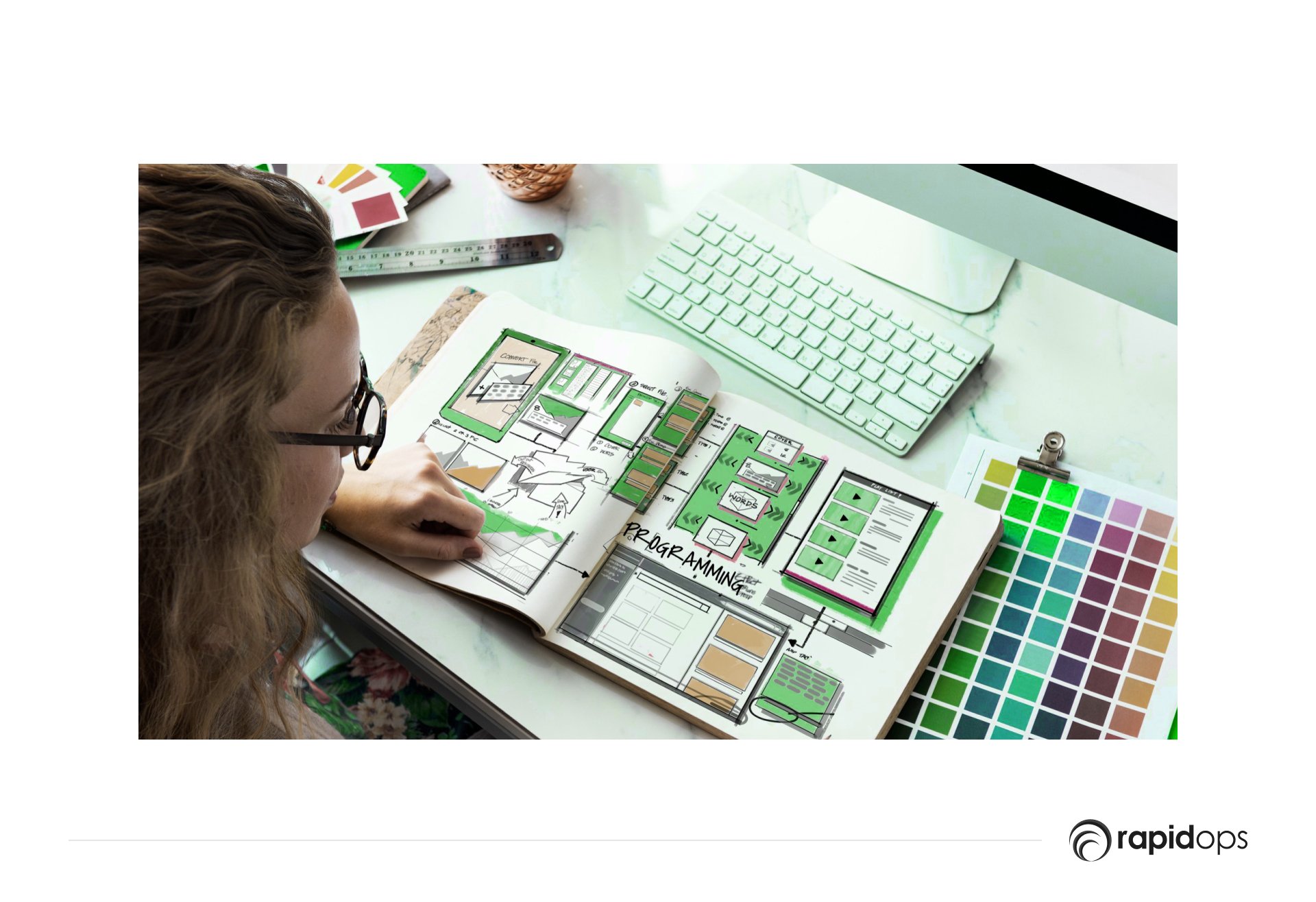
In the digital age, where every touchpoint with customers can be the key to business success or failure, understanding digital product design is vital.
For business owners and decision-makers, this means recognizing the power of well-designed digital products – be they websites, apps, or software systems – as tools for business growth, customer engagement, and brand differentiation.
Strategic impact on business
Digital product design extends far beyond the realm of aesthetics. It strategically influences how customers perceive and interact with your brand.
A business's digital presence can be a major competitive advantage in today's market. Effective digital product design aligns with and supports your business goals, whether increasing customer engagement, driving sales, or enhancing user experience.
Core principles: User-centricity and functionality
The heart of successful digital product design lies in its user-centric approach. This involves in-depth research to understand your own target users and the market's needs, preferences, and behaviors.
The goal is to design intuitive and functional user interfaces that enhance user experience and encourage customer loyalty. For decision-makers, this means prioritizing a design that resonates with the target audience and reflects the brand's ethos.
Understanding different digital products
Digital products vary widely, from mobile apps designed to improve customer service to comprehensive software solutions that streamline business operations.
Each type serves different business needs and offers distinct benefits. Recognizing which digital product aligns with your business objectives is crucial in leveraging technology effectively.
For instance, a well-designed e-commerce platform can significantly boost sales, while an efficient CRM system can enhance customer relationship management.
Role and impact of digital product designers
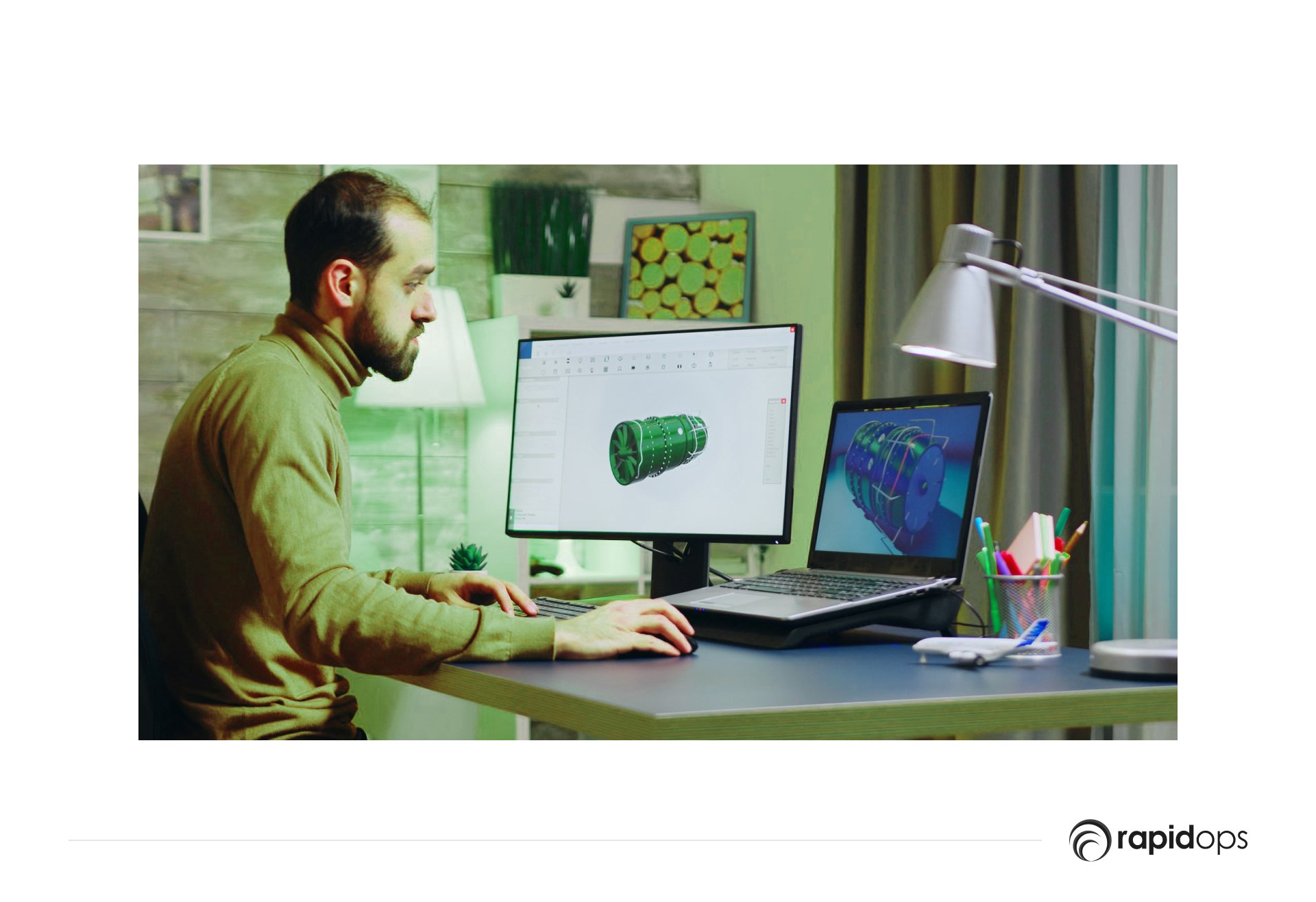
In the digital business ecosystem, understanding the multifaceted role of digital product designers is crucial for business leaders who aim to leverage digital platforms effectively.
Digital product designers are integral to creating successful digital products. Their role goes beyond design; they are key players in ensuring that a digital product meets aesthetic standards and serves as a functional and strategic business tool.
For businesses venturing into the digital realm, partnering with skilled digital product designers can be a game-changer in achieving digital success.
Essential skills and responsibilities
A digital product designer's skill set combines creativity, technical proficiency, and user empathy.
These designers are tasked with more than just creating visually appealing layouts; they are responsible as many ideas for conceptualizing and developing user-centric digital products that align with business objectives.
User-centric design
Their primary responsibility is ensuring the digital product delivers an optimal user experience. This requires a deep understanding of user behavior, needs, and motivations, enabling designers to create intuitive and engaging interfaces.
Collaborative development
Digital product designers often work closely with product managers, developers, and marketers. This collaboration ensures the design is aesthetically pleasing and functional, aligning user flow with technical capabilities and marketing strategies.
Strategic implementation
They are key in translating business goals into digital solutions. Whether it's increasing user engagement, driving sales, or improving customer service, designers must strategically implement design elements to achieve these goals.
Tools and technologies used
The effectiveness of a digital product designer lies in their proficiency with various design tools and technologies. Staying abreast of the latest advancements in design software is essential for creating innovative and effective digital products.
Design software
Mastery of design software such as Adobe XD, Sketch, and Figma is fundamental. These tools enable designers to create wireframes, prototypes, and high-fidelity designs, crucial in visualizing and testing the product before development.
Prototyping tools
InVision and Axure are used to create interactive prototypes. These are essential for testing design concepts and gathering user feedback, which guide further refinements.
Collaboration platforms
With remote work becoming more prevalent, digital product designers increasingly rely on collaboration platforms like Slack, Jira, and Trello. These tools facilitate efficient communication and project management across different teams.
A step-by-step guide to the digital product design process

Now, let’s delve deeper into these phases to understand the intricacies and best practices of digital product design.
Step 1: Empathizing with users
Empathy is the cornerstone of the design process. This step goes beyond mere data collection, seeking to understand and empathize with the users truly. It involves in-depth research and engagement to gather insights into users' experiences and challenges.
Step 2: User journey mapping and user stories
User journey mapping and user stories focus on the target user persona and audience's needs and goals. They help visualize the user’s interaction with the product, highlighting key touchpoints and identifying opportunities to enhance the user experience.
Step 3: Ideation and design thinking
The ideation phase, underpinned by design thinking, is where innovation thrives. It's a time for brainstorming diverse ideas and brainstorm potential solutions, keeping the user’s needs at the forefront. This phase is crucial for exploring creative solutions that are both feasible and desirable.
Step 4: Prototyping and wireframing
Prototyping and wireframing turn ideas into tangible representations. This crucial step involves creating prototypes that range from basic wireframes to interactive models, allowing for visualization and early-stage testing of the product concept.
Step 5: User testing and feedback
The final step involves rigorous user testing and feedback collection. This phase is critical for validating the design, understanding user reactions, and identifying areas for refinement. It ensures that the final product truly resonates with the users and meets their needs.
Effective implementation of design systems
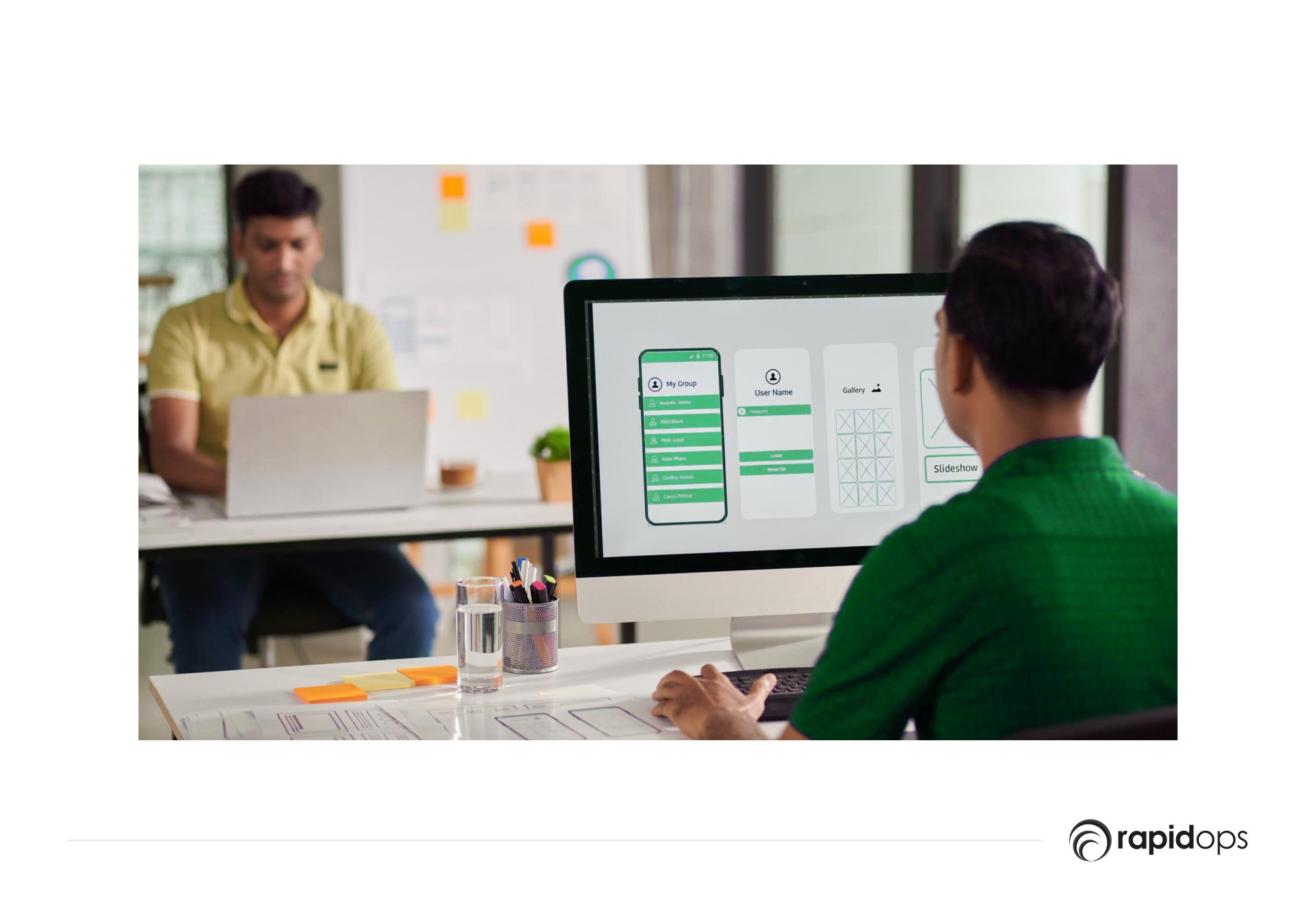
In digital product design, implementing a design system is a strategic approach that streamlines and standardizes the design process.
A design system is more than a collection of reusable components and style guides; it's a comprehensive set of tools and guidelines that ensure consistency and efficiency across a digital product.
Understanding design systems
Concept of design systems
A design system ('design system,' 'design systems') is essentially a 'single source of truth' for all the elements that make up a digital product.
It encompasses design principles, patterns, UI components, and coding standards. This system acts as a reference point for designers and developers, ensuring everyone involved in the product's development is on the same page.
Holistic approach
Design systems integrate both the visual aspects and functional elements of a product. This includes typography, color palettes, grid systems, interactive elements, and the overall look and feel.
It also extends to how components function and interact, ensuring the user experience is consistent and predictable.
Benefits and components of a robust design system
Consistency and cohesion
One of the primary benefits of a robust design system is the consistency it brings to a digital product.
Regardless of who works on the project, the design system ensures that the final product maintains a coherent visual and functional identity. This consistency is key to building trust and recognition with users.
Efficiency and scalability
Design systems streamline the design and development process. They allow for quicker iterations and make scaling up easier.
When new features or pages are added, designers and developers can reference the design system for guidance, reducing the need for repetitive work and decision-making.
Key components
A comprehensive design system includes
- UI components (like buttons, input fields, and models)
- Visual design elements (like color schemes and typography)
- Functional rules (like responsive design principles and accessibility guidelines)
It also encompasses the documentation that explains how and when to use these components.
Effective implementation of design systems in digital product design saves time and resources and ensures that the product remains consistent and user-friendly as it evolves.
This means a more streamlined workflow, a cohesive brand identity, and a better overall business user experience.
Integrating user feedback and testing
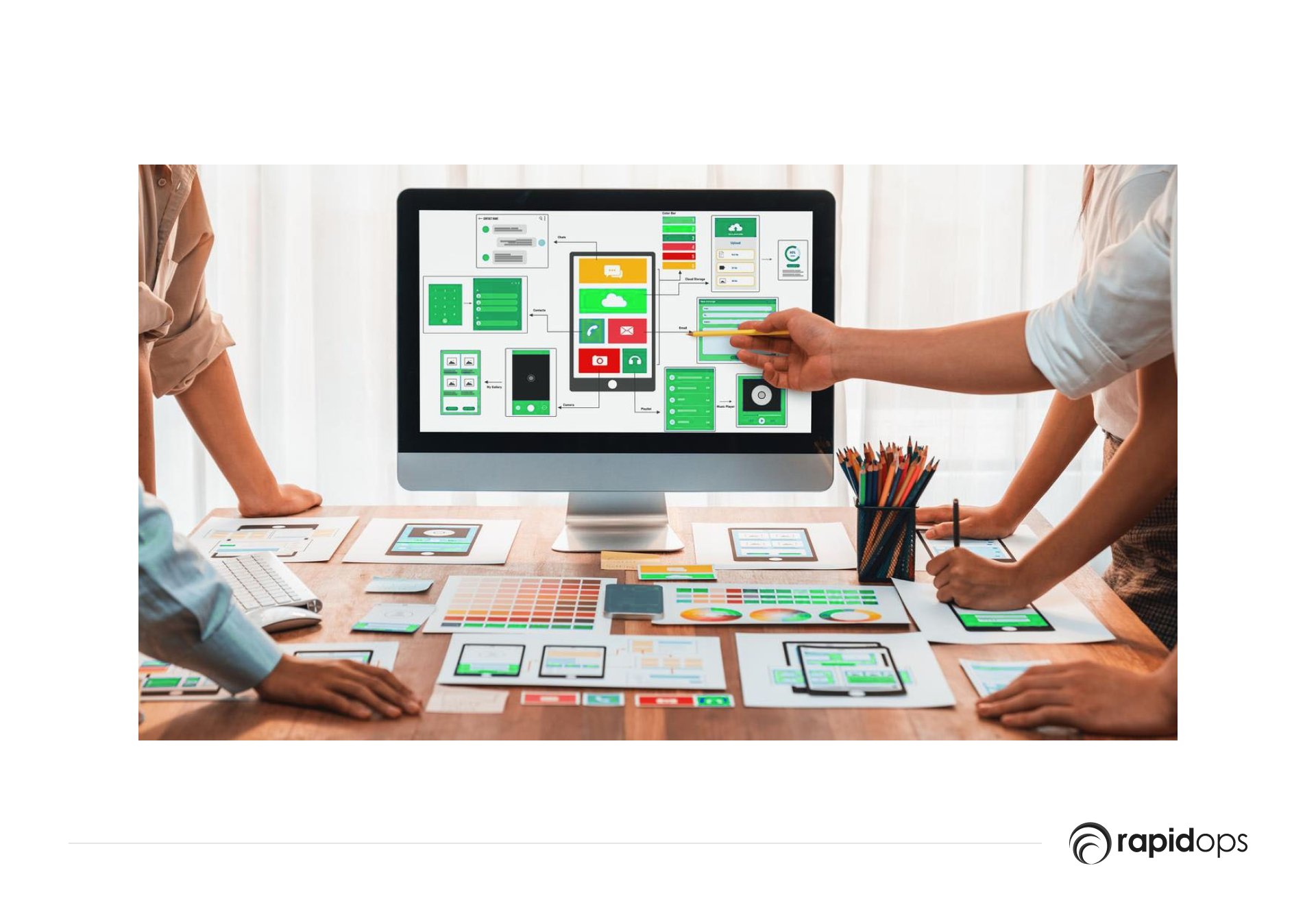
In the landscape of digital product design services, integrating user feedback and conducting thorough testing are not mere steps in the process; they are indispensable practices that ensure the creation of products that genuinely resonate with users.
This approach aligns the product vision with user expectations and paves the way for continuous improvement and innovation.
Importance of User-centered feedback: Gathering insights for informed design
Collecting and analyzing user feedback
Gathering 'user feedback' is critical in understanding how real users interact with and how potential users perceive a digital product. This feedback can be collected through various methods, such as surveys, user interviews, and feedback forms.
The key is to create channels where users can easily provide their input, whether it's praise, criticism, or suggestions. Once collected, analyzing this 'feedback' is vital to identify common themes or issues that need addressing.
This analysis helps make informed decisions about design changes, feature enhancements, and new functionalities.
Conducting usability tests
'Usability testing' is another crucial component in the user feedback loop. These 'tests' are designed to observe how actual users use the product in real-world scenarios.
They help uncover usability issues that might not be apparent to designers and developers.
Usability tests can range from controlled lab sessions to remote testing methods, providing valuable insights into user behavior, preferences, and challenges.
This direct input from end-users ensures that the product is functional but also intuitive and user-friendly.
Iterative design and continuous improvement: Evolving products through user insights
Implementing user suggestions
The true power of 'user testing' lies in its ability to inform the iterative design process. By consistently 'implementing user suggestions,' digital products can evolve in ways that genuinely meet user needs.
This iterative approach involves making incremental changes based on user feedback, testing these changes, and then refining further. It's a cycle that continuously enhances the product, ensuring it remains relevant and effective.
Measuring success and impact
Setting and monitoring 'success metrics' is essential to quantify the impact of these iterations. These metrics could include user engagement rates, conversion rates, customer satisfaction scores, or any other relevant indicators of 'user experience' success.
By continually measuring these metrics, businesses can gauge the effectiveness of their design changes and understand the overall impact on the user experience.
Advanced tools and techniques
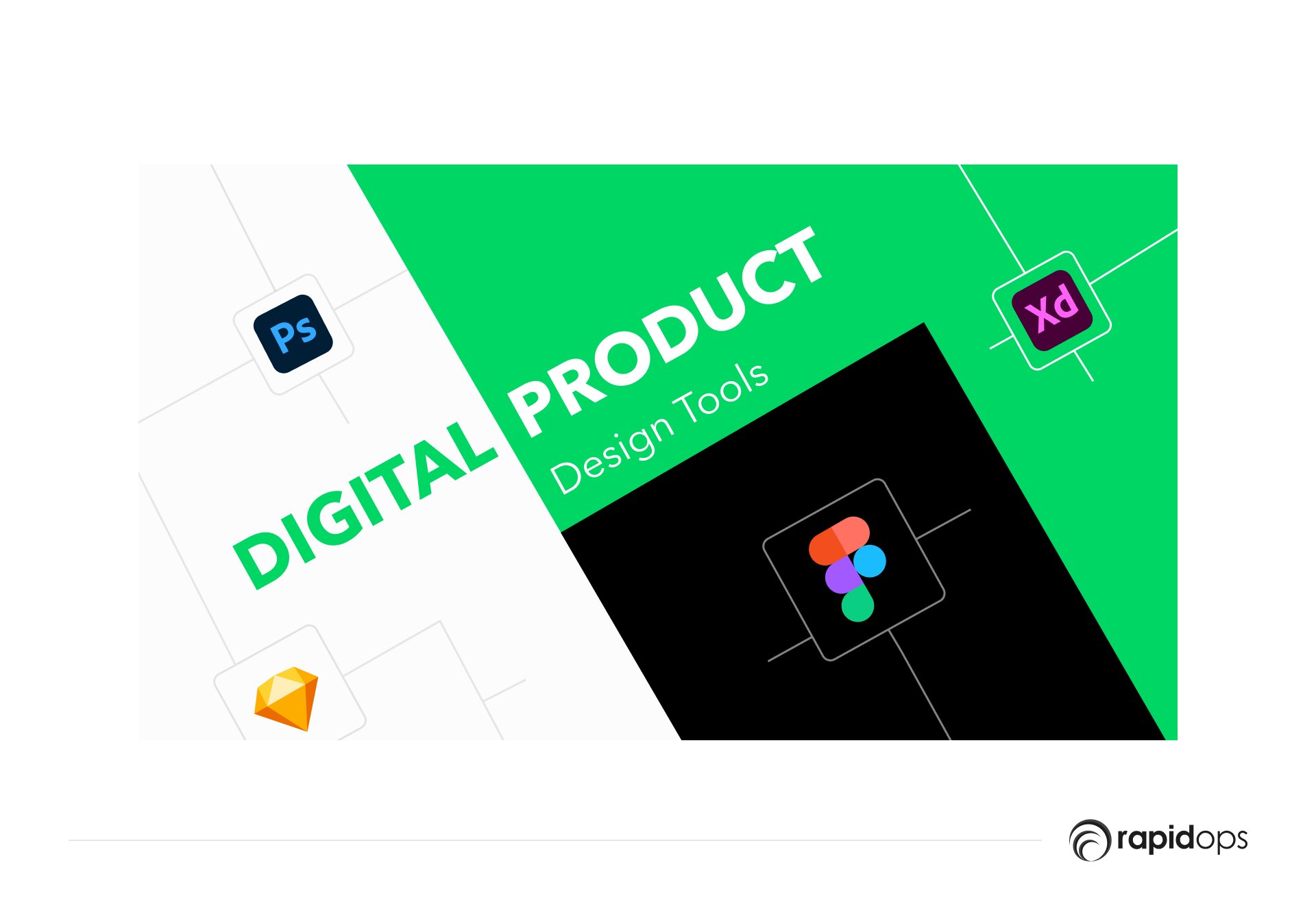
In the dynamic world of digital product design services, using advanced tools and techniques is pivotal for crafting innovative and user-centric products.
As technology evolves, so do designers' tools and methodologies to bring digital products to life.
This section delves into the cutting-edge software and tools essential in modern digital product design services and highlights the importance of designing for accessibility across multiple devices.
Overview of cutting-edge design software and tools
The digital product design services landscape has various sophisticated software and tools, each offering unique features and capabilities.
Tools like Adobe XD, Sketch, and Figma lead the pack, which have become staples in the designer's toolkit.
These platforms offer a range of functionalities, from wireframing and prototyping to collaboration and feedback gathering, all within a single interface.
They enable designers to create detailed and interactive models of their products, providing a realistic preview of how they will look and function.
Moreover, tools like InVision and Axure offer advanced prototyping capabilities, allowing designers to create highly interactive prototypes that closely mimic the final product.
This is crucial for testing and refining user interfaces and interactions.
Additionally, modern design tools increasingly integrate AI and machine learning algorithms, offering designers new ways to automate processes, generate ideas, and analyze user data.
Emphasizing accessibility and multi-device design
An essential aspect of digital product design today is ensuring accessibility.
Designers must use 'accessibility resources' to ensure that digital products are usable by people with various disabilities. This includes designing for screen readers, ensuring adequate color contrast, and providing alternative text for images.
Tools like WebAIM and AXE are instrumental in helping designers create products that are accessible to all users.
Furthermore, with the growing variety of devices and screen sizes, designing for 'multiple devices' has become non-negotiable.
Responsive design tools and techniques ensure that digital products provide a seamless user experience across different devices, be it smartphones, tablets, or desktops.
This approach enhances user engagement and contributes to a wider reach and better product performance across different platforms.
Mastering product design with some practical tips
Crafting a successful digital product is both an art and a science. It requires a careful balance of creative intuition and strategic planning.
For businesses and designers aiming to excel in this field, here are some practical tips that bring together user-centric design, product research, data-driven insights, and effective collaboration.
Focusing on user needs and solutions
Identifying and addressing user needs
The cornerstone of digital product design services is a deep understanding of 'user needs.' This involves engaging with your target audience to understand their challenges, preferences, and behaviors.
Tools like user personas and journey mapping can help in visualizing these needs and potential solutions. The goal is to create 'products' that offer practical solutions and enhance the user experience.
Iterative design based on feedback
Once the product is conceptualized, adopting an iterative design approach is essential. This means continuously refining the product based on user feedback and testing.
Such an approach ensures that the product evolves in response to user requirements, leading to higher satisfaction and engagement.
Data-driven design and aesthetics balance
Leveraging data in design decisions
'Data-driven design' involves using quantitative and qualitative data to inform design choices.
This could mean analyzing user interaction data to optimize UI layouts or conducting A/B tests to determine which features resonate most with users.
Data-driven insights help make informed decisions that enhance the functionality and appeal of the product.
Harmonizing functionality with visual design
While functionality is paramount, a product's 'visual aspects' are critical in attracting and retaining users. The aesthetic appeal of a product should complement its usability, creating a harmonious user experience. This balance is key in designing and creating products that are not only efficient but also enjoyable to use.
Collaboration and effective project management
Fostering team collaboration
Digital product design services is rarely a solo endeavor; it involves the collaboration of designers, developers, project managers, and other stakeholders. Effective 'project management' is crucial in orchestrating these efforts. Utilizing tools and platforms that facilitate communication and workflow management can greatly enhance design team synergy.
Involving the entire team in the design process
Successful digital products are often the result of collaborative efforts where every team member's input is valued. Involving the 'entire team' in the design process, including developers, marketers, and customer support, can provide diverse perspectives and lead to more innovative solutions.
The importance of having a product design strategy

Building a successful digital product design strategy is a complex yet rewarding endeavor. It requires a deep understanding of user needs, market dynamics, and technological possibilities.
By focusing on these critical elements and navigating common challenges, businesses can create digital products that meet and exceed user expectations, securing a competitive edge in the digital marketplace.
This strategic approach ensures that businesses keep pace with the evolving digital landscape and shape it to their advantage.
A digital product design strategy is more than a roadmap; it's a fusion of art and science, where every feature, interaction, and pixel plays a critical role in user experience.
This strategy is not just about the 'what' of the product but significantly about the 'how.' It involves understanding the customer journey, their interactions with digital interfaces, and how these elements collectively enhance the user experience.
The strategy's role in business evolution
The approach to digital product design services acts as a catalyst, captivating potential customers and augmenting a company's value proposition.
As businesses navigate the digital-first world, a well-conceived product design strategy becomes a crucial tool, shaping companies' future. This strategy helps in understanding:
- Consumer motivations: Grasping what drives customers to use the product, tapping into their true nature and preferences.
- Market fit and competitive edge: Identifying the product's place in the market and leveraging its unique advantages.
- Growth strategies: Outlining tactics to accelerate product growth and adapt to market changes.
Crucial elements of a digital design strategy
- Customer-centric design: At the strategy's core is the end-user. Understanding their needs and behaviors is vital in designing an engaging and seamless user experience.
- Market research: Invaluable in shaping the strategy, market research involves analyzing customer trends, preferences, and demographics, ensuring the product aligns with current market dynamics.
- Competitive analysis: Studying competitors' strengths and weaknesses offers insights into market gaps and opportunities for differentiation.
- Prototyping: Creating preliminary product versions to test and validate ideas helps in early problem identification and solution.
- Wireframing: This step provides a structural visual guide, aligning the team's vision and reducing miscommunications.
- MVP development: Developing a Minimum Viable Product to test market fit and user response without extensive initial investment.
- Time-to-market: Balancing rapid development with maintaining product quality is crucial in the fast-evolving digital arena.
Navigating common pitfalls
Success in digital product design strategy also involves awareness of potential pitfalls:
- Lack of clear vision: A clear and coherent vision is paramount for the strategy's success, encompassing the product's purpose, target audience, and user experience.
- Insufficient user research: Deep user insights are critical. Products designed without thorough user research may not resonate with the intended audience.
- Ignoring market dynamics: A successful product considers market competition, timing, and pricing in its strategy.
- Inadequate testing: Comprehensive user testing is essential. Launching without proper testing may lead to overlooked issues and user dissatisfaction.
Discovering some real-world success stories
Diving into real-world success stories offers invaluable insights into how digital product design can drive business growth and enhance user experience. We can extract key lessons and best practices in digital product design by examining market leaders like Airbnb, Duolingo, Uber, Slack, and Coca-Cola.
Airbnb: Enhancing the booking experience

Airbnb's user-centered redesign significantly transformed the online accommodation booking experience. The redesign addressed critical user pain points in the booking process by focusing on trust, transparency, and ease of use.
Key design elements included professional photos, detailed descriptions, a straightforward booking process, and a secure payment system. These thoughtful design choices increased bookings and facilitated Airbnb's expansion to over 6 million listings in more than 220 countries by 2022.
The continuous evolution of Airbnb's user interface design (UI), underpinned by extensive user research, testing, and an emphasis on simplicity and clarity, aligned the visual design with the emotional aspects of travel.
This approach has contributed significantly to Airbnb's business growth, showcasing the power of user-centric design in the travel industry.
In-Depth Analysis
- Trust and Transparency: Airbnb's redesign was pivotal in addressing trust and transparency issues, which are crucial in the accommodation booking industry. The focus was on making users feel secure and informed throughout the booking process.
- Professional Photography and Descriptions: Using high-quality images and detailed property descriptions significantly enhanced the user experience by providing clarity and building confidence in their choices.
- Streamlined Booking Process: Simplifying the booking process eliminated user frustration, leading to increased bookings and user satisfaction.
Lessons and Best Practices:
- User-Centric Design: Prioritizing user pain points and preferences in design decisions can lead to greater user satisfaction and loyalty.
- Continuous UI Evolution: Regularly updating the user interface based on user feedback and trends ensures the product remains relevant and user-friendly.
Duolingo: Revolutionizing language learning
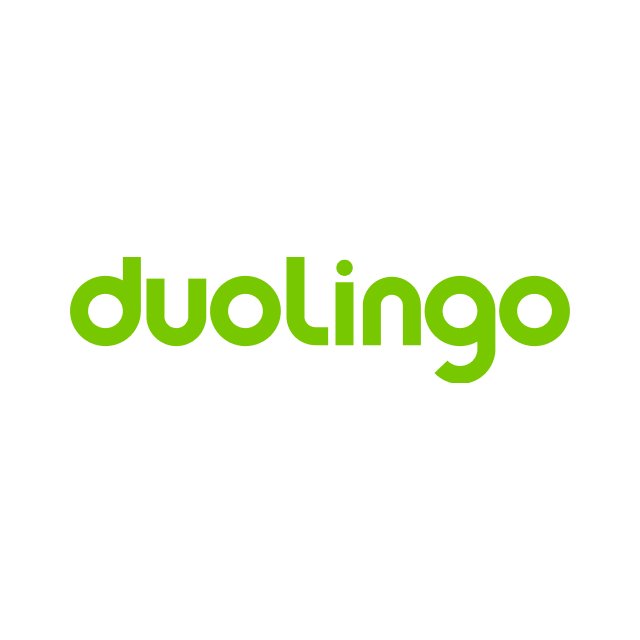
Duolingo's success in the language learning domain is attributed to its gamified learning approach, which makes the process fun and engaging.
The design highlights of Duolingo include bite-sized lessons, points, badges, leaderboards, and personalized learning paths that keep users motivated and engaged.
This approach has led to remarkable adoption and reach, with over 500 million downloads and 40 million active users.
Duolingo's success demonstrates the effectiveness of gamification in making language learning accessible and enjoyable, proving that educational apps can achieve widespread popularity through thoughtful design.
In-Depth Analysis:
- Gamified Learning Experience: Duolingo's gamification elements, such as points and leaderboards, transformed language learning from mundane tasks to engaging activities. This approach significantly increased user engagement and retention.
- Personalized Learning Paths: Offering customized learning experiences catered to individual progress and preferences contributed to its widespread user adoption.
Lessons and Best Practices:
- Engagement Through Gamification: Incorporating game-like elements can significantly increase user engagement and motivation.
- Personalization: Tailoring the user experience to individual needs and preferences can lead to a more effective and enjoyable learning process.
Uber: Transforming urban mobility

Uber has transformed urban mobility with its user-friendly app design, allowing users to request rides easily. Key features like real-time driver tracking, multiple payment options, and a streamlined ride-hailing process have been central to its user experience.
This intuitive design has been pivotal in Uber's rapid growth and global expansion, operating in over 70 countries with over 100 million users.
Uber's success story highlights the importance of simple and intuitive design in service-oriented apps, emphasizing how user-friendly design can lead to market leadership.
In-Depth Analysis:
- Intuitive App Interface: Uber's simple and user-friendly interface revolutionized the ride-hailing experience, making it accessible to a broad user base.
- Key Functionalities: Features like real-time driver tracking and multiple payment options addressed key user needs and enhanced the overall experience.
Lessons and Best Practices:
- Simplicity in Design: A straightforward and intuitive design can be a major differentiator in service-oriented apps.
- User Convenience: Prioritizing user convenience in design can lead to rapid market adoption and leadership.
Slack: Enhancing workplace communication

Slack has redefined workplace communication by continuously improving its user experience (UX), focusing on intuitive interactions essential to creating software used for productivity and collaboration.
Design improvements like simplified navigation, streamlined messaging, and additional functionalities have enhanced productivity for users.
These UX enhancements have attracted a large user base, driving adoption rates and customer loyalty, thereby establishing Slack as a leading tool in its sector.
Slack's journey underscores the value of continuous UX improvement in fostering user adoption and loyalty in digital products.
In-Depth Analysis:
- Continuous UX Improvement: Slack’s commitment to evolving its UX design, focusing on user-friendly interactions, has been key to its success in the competitive workspace communication market.
- Design Improvements: Enhancements in navigation and messaging functionalities significantly improved productivity and user satisfaction.
Lessons and Best Practices:
- Importance of UX in Productivity Tools: Investing in continuous UX improvements can significantly impact user adoption and loyalty.
- Balancing Functionality and Simplicity: A design that balances sophisticated functionality with ease of use can lead to a more productive and enjoyable user experience.
Coca-Cola: Innovative packaging design

Coca-Cola's innovative packaging design strategy, aligning with consumer preferences and sustainability, introduced modern, sustainable packaging options.
This strategic move refreshed the brand's image, connecting with new generations and maintaining loyal customers, increasing sales and market share.
The focus on personalized packaging options further strengthened the emotional connection with consumers, demonstrating how thoughtful packaging design can significantly impact consumer perception and business success.
In-Depth Analysis:
- Alignment with Consumer Trends: Coca-Cola’s shift to modern, sustainable packaging resonated with contemporary consumer values, particularly among younger demographics.
- Personalization: The focus on personalized packaging options created a unique emotional connection with consumers, enhancing brand loyalty.
Lessons and Best Practices:
- Adaptation to Consumer Preferences: Aligning design strategy with evolving consumer trends can significantly enhance brand perception and market presence.
- Emotional Connection Through Design: Personalization in design can foster a stronger emotional bond between the brand and its consumers.
Conclusion: Navigating the future of digital product design

As we conclude this comprehensive journey through digital product design, it's clear that this field is not just about aesthetics or technology—it's about creating meaningful user interactions and experiences.
The key insights from this guide underscore the importance of user-centric design, strategic implementation, and continuous innovation in crafting digital products that resonate with users and drive business success.
The landscape of digital product design is poised for continuous evolution. Emerging technologies, changing user behaviors, and new market demands will shape the future of design.
This underscores the importance of continued learning, staying abreast of the latest trends, and adapting to new methodologies for businesses, designers, and decision-makers.
Embracing this ever-changing landscape of digital product design requires a mindset of curiosity, flexibility, and a commitment to ongoing improvement.
Whether you're a seasoned designer, a business leader making strategic decisions, or part of a team collaborating on your next digital venture, the future is bright.
Digital product design offers exciting opportunities for growth, innovation, and creating impactful digital experiences.
Rapidops: Your digital product development and experience design partner
In today's digital-first world, the journey from a nascent idea to a market-ready product is intricate and demanding. That's where Rapidops steps in as your ideal partner, transforming your visionary concepts into digital products that meet and exceed market expectations.
Why choose Rapidops for your next digital product development project?
- Expertise in end-to-end development: From initial discovery and ideation to final deployment and continuous improvement, Rapidops covers every phase of the product development lifecycle. Our team excels in crafting strategies, designing compelling user experiences, and engineering robust software solutions.
- User-centric experience design: Our approach's core lies in a deep understanding of user needs and behaviors. With our expertise in UX/UI design, we create interfaces that are not only visually stunning but also highly intuitive and engaging, ensuring your product resonates with its intended audience.
- Advanced technological capabilities: Whether it's mobile app development, sophisticated web solutions, cloud migration, or leveraging emerging technologies like AI and IoT, Rapidops is at the forefront of technological innovation. Our solutions are tailored to be future-proof and scalable.
- Proven track record with diverse industries: Our portfolio spans across various sectors, demonstrating our ability to adapt and excel in different market environments. Rapidops has a history of delivering excellence and driving growth from startups to established enterprises.
- Agile and adaptive approach: Agility is key in a fast-paced digital landscape. Rapidops adopts an agile methodology, ensuring flexibility, faster time to market, and the ability to iterate based on user feedback and market changes rapidly.
- Focus on building long-term relationships: We believe in growing with our clients. Our commitment extends beyond the project completion, as we offer continuous support and insights to keep your product ahead of the curve.
Embark on a journey of digital excellence with Rapidops
As your digital product development partner, Rapidops is dedicated to turning your ambitious visions into reality. Our team's passion, cutting-edge technology, and user-centric design philosophy ensure your product stands out in the crowded digital space.
Are you ready to embark on this transformative journey? Join hands with Rapidops, and let's build digital solutions that define tomorrow. Visit Rapidops to start your path toward digital innovation and success.

Saptarshi Das
Content Editor
9+ years of expertise in content marketing, SEO, and SERP research. Creates informative, engaging content to achieve marketing goals. Empathetic approach and deep understanding of target audience needs. Expert in SEO optimization for maximum visibility. Your ideal content marketing strategist.
What’s Inside
- Why is digital product design important?
- The digital revolution in product design
- Decoding digital product design
- Role and impact of digital product designers
- A step-by-step guide to the digital product design process
- Effective implementation of design systems
- Integrating user feedback and testing
- Advanced tools and techniques
- Mastering product design with some practical tips
- The importance of having a product design strategy
- Discovering some real-world success stories
- Conclusion: Navigating the future of digital product design
- Rapidops: Your digital product development and experience design partner

Let’s build the next big thing!
Share your ideas and vision with us to explore your digital opportunities
Similar Stories

Receive articles like this in your mailbox
Sign up to get weekly insights & inspiration in your inbox.



